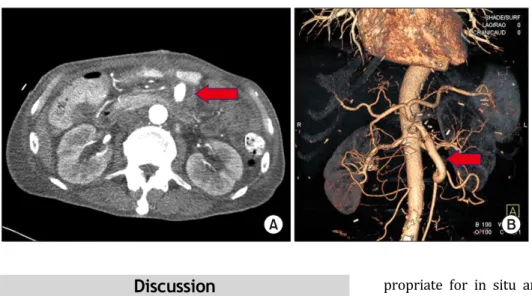ISSN: 2233-601X (Print) ISSN: 2093-6516 (Online)
− 209 −
Received: September 25, 2017, Revised: October 25, 2017, Accepted: November 1, 2017, Published online: June 5, 2018
Corresponding author: Keon Hyon Jo, Department of Thoracic and Cardiovascular Surgery, Seoul St. Mary’s Hospital, College of Medicine, The Catholic University of Korea, 222 Banpo-daero, Seocho-gu, Seoul 06591, Korea
(Tel) 82-2-2258-2858 (Fax) 82-2-594-8644 (E-mail) khjo@cmcnu.or.kr
© The Korean Society for Thoracic and Cardiovascular Surgery. 2018. All right reserved.
This is an open access article distributed under the terms of the Creative Commons Attribution Non-Commercial License (http://creativecommons.org/
licenses/by-nc/4.0) which permits unrestricted non-commercial use, distribution, and reproduction in any medium, provided the original work is properly cited.
Open Surgical Repair Using the Femoral Vein for a Mycotic Superior Mesenteric Artery Aneurysm
Min Namkoong, M.D. 1 , Seok Beom Hong, M.D. 1 , Hwan Wook Kim, M.D. 1 , Keon Hyon Jo, M.D. 1 , Jang Yong Kim, M.D. 2
1

